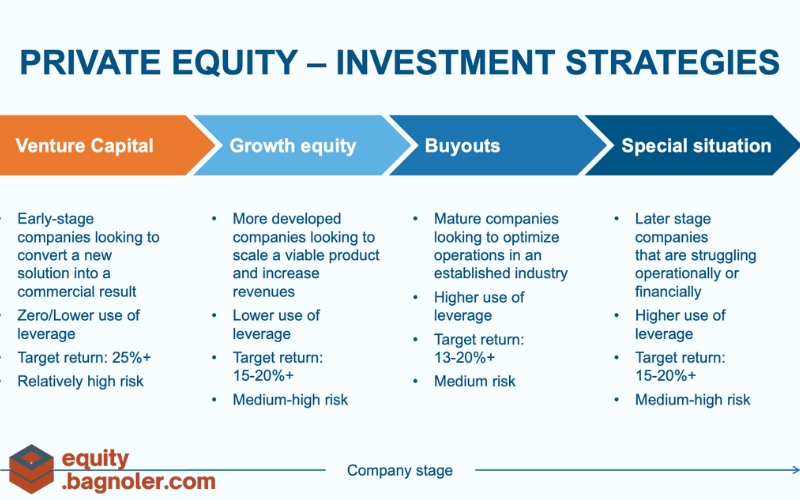With the potential for high returns, but also with certain risks, building and applying an equity investment strategy is very important. To optimize opportunities and minimize risks, investors need to master effective strategies, which can be long-term, short-term, or based on fundamental and technical analysis. In this article, we will learn in detail about popular equity investment strategies and how to apply them to achieve financial goals.
1. LONG-TERM INVESTMENT AND INVESTMENT IN POTENTIAL BUSINESSES
One of the most popular equity investment strategies is long-term investment. This strategy focuses on finding companies with strong growth potential in the future and holding the stocks for a long time to benefit from that growth. These companies often have strong fundamentals, sustainable business models, and high growth potential.
Long-term investors look for businesses with outstanding competitive advantages, talented leadership teams, and healthy financial indicators. By holding stocks for the long term, investors can take advantage of the growth in stock value and gain profits from receiving dividends. A long-term investment strategy often requires investors to be patient and have a long-term vision.

2. CONCENTRATED INVESTING
Concentrated investing is a strategy of investing in a small number of stocks that the investor believes will bring the highest returns in the long term. Instead of allocating capital to a diversified portfolio of stocks, this strategy requires investors to focus on a few companies that they believe will achieve strong growth. This allows investors to take advantage of large investments in potential stocks.
Although concentrated investing can bring high returns, it also comes with a greater level of risk because of the dependence on a few companies. If these companies do not perform well, investors can suffer serious losses. Therefore, this strategy requires careful research and analysis to ensure that the selected stocks really have potential.
3. VALUE INVESTING
Value investing is a strategy of investing in stocks that are undervalued by the market compared to their true value. Investors following this strategy believe that the market can sometimes misjudge a company’s true value, leading to its shares being sold at a discount. They look for opportunities to invest in companies that are being overlooked by the market or that have a market value that is lower than their actual asset value and future potential.
The key to value investing is patience, as it can take a long time for the market to recognize a company’s true value. Famous value investors such as Warren Buffett have built their financial empires on this strategy, which is based on finding businesses with outstanding value but that are undervalued in the short term.
4. GROWTH INVESTING
Unlike value investing, growth investing focuses on finding companies that have the potential to grow rapidly and sustainably in the future. Investors following this strategy typically look for companies with innovative business models, breakthrough products or services, and the ability to scale quickly. While growth stocks are often priced higher than their current value, investors believe that the potential for future growth will drive the stock price up.
Technology, healthcare, and other highly innovative industries are common areas that growth investors look for. However, this strategy also carries risks, as many growth companies may fail to meet future earnings expectations, leading to a decline in stock value.
5. TECHNICAL ANALYSIS INVESTING
Technical analysis is a strategy in which investors use charts, indicators, and historical data to predict future stock price trends. Technical analysis focuses on studying market behavior and technical factors such as trading volume, price patterns, and other technical indicators. Investors use technical analysis to find the right time to buy or sell stocks.
This strategy requires investors to have a good understanding of technical analysis tools and the ability to read charts, as well as the ability to predict market trends. Although technical analysis can help optimize short-term profits, this strategy does not guarantee success and can be easily affected by market fluctuations.
6. INFORMATION-BASED INVESTING
Information-based investing is a strategy in which an investor seeks to take advantage of non-public or little-known information about the market. This may include information about upcoming events, changes in the industry, or changes in policy that may affect the value of a stock. Investors using this strategy need to be quick to gather and analyze information, and have the ability to make quick decisions.
Information-based investing can yield significant profits if the investor has access to valuable information before others. However, this strategy also carries risks, as information is not always accurate or easy to predict.
CONCLUSION
In short, equity investment strategies can be applied in many different ways, depending on the goals and risk appetite of each investor. Each strategy has its own advantages and disadvantages, and investors need to choose the strategy that suits their financial situation and personal investment strategy. An effective investment strategy depends not only on choosing the right company, but also on the investor’s patience, research ability, and risk control ability.
